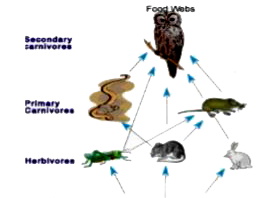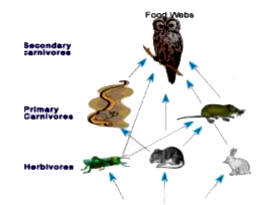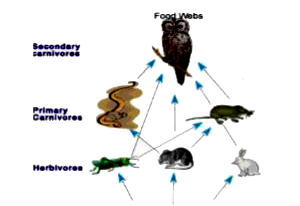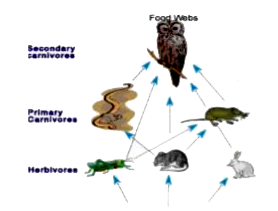$ The microfossils discovered in the earth's oldest fossil bearing rocks resemble the eubacterian and some photosynthetic cyano-bacteria.
! It indicates that the simple organisms are believed to be the ancestors of all the complex forms.
If both As and R are correct and R is correct explanation of As
If both As and R are correct but R is not correct explanation of As
If As is correct, R is wrong
If both As and R are wrong.
The correct Answer is:A
Step by step video, text & image solution for $ The microfossils discovered in the earth's oldest fossil bearing rocks resemble the eubacterian and some photosynthetic cyano-bacteria. ! It indicates that the simple organisms are believed to be the ancestors of all the complex forms. by Biology experts to help you in doubts & scoring excellent marks in Class 12 exams.
Updated on:21/07/2023Topper's Solved these Questions
- ENVIRONMENTAL ISSUESBOOK - DINESH PUBLICATIONCHAPTER - ENVIRONMENTAL ISSUESEXERCISE - Model test paper-1
100 Videos
- ENVIRONMENTAL ISSUESBOOK - DINESH PUBLICATIONCHAPTER - ENVIRONMENTAL ISSUESEXERCISE - Model test paper-2
100 Videos
- ENVIRONMENTAL ISSUESBOOK - DINESH PUBLICATIONCHAPTER - ENVIRONMENTAL ISSUESEXERCISE - Brain teasers-X
145 Videos
- ECHINODERMATABOOK - DINESH PUBLICATIONCHAPTER - ECHINODERMATAEXERCISE - REVISION QUESTIONS
65 Videos
- EVIDENCES OF EVOLUTIONBOOK - DINESH PUBLICATIONCHAPTER - EVIDENCES OF EVOLUTIONEXERCISE - CHECK YOUR GRASP
3 Videos
Similar Questions
Food chains are very important for the survival of most species. When only one element is removed from the food chain it can result in extinction of a species in some cases. The foundation of the food chain consists of primary producers
Primary producers, or autotrophs, can use either solar energy or chemical energy to create complex organic compounds, whereas species at higher trophic levels cannot and so must consume producers or other life that itself consumes producers. Because the sun's light is necessary for photosynthesis, most life could not exist if the sun disappeared. Even so, it has recently been discovered that there are some forms of life, chemotrophs, that appear to gain all their metabolic energy from chemosythesis driven by hydrothermal vents, thus showing that some life may not require solar energy to thrive.

The decomposers are not included in the food chain. The correct reason for the same is because decomposers:
View SolutionFood chains are very important for the survival of most species. When only one element is removed from the food chain it can result in extinction of a species in some cases. The foundation of the food chain consists of primary producers
Primary producers, or autotrophs, can use either solar energy or chemical energy to create complex organic compounds, whereas species at higher trophic levels cannot and so must consume producers or other life that itself consumes producers. Because the sun's light is necessary for photosynthesis, most life could not exist if the sun disappeared. Even so, it has recently been discovered that there are some forms of life, chemotrophs, that appear to gain all their metabolic energy from chemosythesis driven by hydrothermal vents, thus showing that some life may not require solar energy to thrive.

Matter and energy are two fundamental inputs of an ecosystem. Movement of
View Solution
Knowledge Check
Direction : Read the passage completely to answer the questions from the given options.
The phrase "What is it like?" stands for a fundamental thought process. How does one go about observing and reporting on things and events that occupy segments of earth space? Of all the infinite variety of phenomena on the face of the earth, how does one decide what phenomena to observe? There is no such thing as a complete description of the earth or any part of it, for every microscopic point on the earth's surface differs from every other such point. Experience shows that the things observed are already familiar, because they are like phenomena that occur at home or because they resemble the abstract images and models developed in the human mind.
How are abstract images formed? Humans alone among the animals possess language, their words symbolize not only specific things but also mental images of classes of things. People can remember what they have seen or experienced because they attach a word symbol to them.
During the long record of our efforts to gain more and more knowledge about the face of the earth as the human habitat, there has been a continuing interplay between things and events. The direct observation through the senses is described as a percept, the mental image is described as a concept. Percepts are what some people describe as reality, in contrast to mental images, which are theoretical, implying that they are not real.
The relation of Percept to Concept is not as simple as the definition implies. It is now quite clear that people of different cultures or even individuals in the same culture develop different mental images of reality and what they perceive is a reflection of these preconceptions. The direct observation of things and events on the face of the earth is so clearly a function of the mental images of the mind of the observer that the whole idea of reality must be reconsidered.
Concepts determine what the observer perceives, yet concepts are derived from the generalizations of previous percepts. What happens is that the educated observer is taught to accept a set of concepts and then sharpens or changes these concepts during a professional career. In any one field of scholarship, professional opinion at one time determines what concepts and procedures are acceptable, and these form a kind of model of scholarly behaviour.
In the passage, the earth is taken asAThe GlobeBThe Human HabitatCA Celestial BodyDA PlanetDirection : Read the passage completely to answer the questions from the given options.
The phrase "What is it like?" stands for a fundamental thought process. How does one go about observing and reporting on things and events that occupy segments of earth space? Of all the infinite variety of phenomena on the face of the earth, how does one decide what phenomena to observe? There is no such thing as a complete description of the earth or any part of it, for every microscopic point on the earth's surface differs from every other such point. Experience shows that the things observed are already familiar, because they are like phenomena that occur at home or because they resemble the abstract images and models developed in the human mind.
How are abstract images formed? Humans alone among the animals possess language, their words symbolize not only specific things but also mental images of classes of things. People can remember what they have seen or experienced because they attach a word symbol to them.
During the long record of our efforts to gain more and more knowledge about the face of the earth as the human habitat, there has been a continuing interplay between things and events. The direct observation through the senses is described as a percept, the mental image is described as a concept. Percepts are what some people describe as reality, in contrast to mental images, which are theoretical, implying that they are not real.
The relation of Percept to Concept is not as simple as the definition implies. It is now quite clear that people of different cultures or even individuals in the same culture develop different mental images of reality and what they perceive is a reflection of these preconceptions. The direct observation of things and events on the face of the earth is so clearly a function of the mental images of the mind of the observer that the whole idea of reality must be reconsidered.
Concepts determine what the observer perceives, yet concepts are derived from the generalizations of previous percepts. What happens is that the educated observer is taught to accept a set of concepts and then sharpens or changes these concepts during a professional career. In any one field of scholarship, professional opinion at one time determines what concepts and procedures are acceptable, and these form a kind of model of scholarly behaviour.
The problem raised in the passage reflects onAThought processBHuman behaviourCCultural perceptionsDProfessional opinionDirection : Read the passage completely to answer the questions from the given options.
The phrase "What is it like?" stands for a fundamental thought process. How does one go about observing and reporting on things and events that occupy segments of earth space? Of all the infinite variety of phenomena on the face of the earth, how does one decide what phenomena to observe? There is no such thing as a complete description of the earth or any part of it, for every microscopic point on the earth's surface differs from every other such point. Experience shows that the things observed are already familiar, because they are like phenomena that occur at home or because they resemble the abstract images and models developed in the human mind.
How are abstract images formed? Humans alone among the animals possess language, their words symbolize not only specific things but also mental images of classes of things. People can remember what they have seen or experienced because they attach a word symbol to them.
During the long record of our efforts to gain more and more knowledge about the face of the earth as the human habitat, there has been a continuing interplay between things and events. The direct observation through the senses is described as a percept, the mental image is described as a concept. Percepts are what some people describe as reality, in contrast to mental images, which are theoretical, implying that they are not real.
The relation of Percept to Concept is not as simple as the definition implies. It is now quite clear that people of different cultures or even individuals in the same culture develop different mental images of reality and what they perceive is a reflection of these preconceptions. The direct observation of things and events on the face of the earth is so clearly a function of the mental images of the mind of the observer that the whole idea of reality must be reconsidered.
Concepts determine what the observer perceives, yet concepts are derived from the generalizations of previous percepts. What happens is that the educated observer is taught to accept a set of concepts and then sharpens or changes these concepts during a professional career. In any one field of scholarship, professional opinion at one time determines what concepts and procedures are acceptable, and these form a kind of model of scholarly behaviour.
The relation of Percept to Concept isAPositiveBNegativeCReflectiveDAbsolute
Food chains are very important for the survival of most species. When only one element is removed from the food chain it can result in extinction of a species in some cases. The foundation of the food chain consists of primary producers
Primary producers, or autotrophs, can use either solar energy or chemical energy to create complex organic compounds, whereas species at higher trophic levels cannot and so must consume producers or other life that itself consumes producers. Because the sun's light is necessary for photosynthesis, most life could not exist if the sun disappeared. Even so, it has recently been discovered that there are some forms of life, chemotrophs, that appear to gain all their metabolic energy from chemosythesis driven by hydrothermal vents, thus showing that some life may not require solar energy to thrive.

If 10,000 J solar energy falls on green plants in a terrestrial ecosystem, what percentage of solar energy will be converted into food energy?
View SolutionFood chains are very important for the survival of most species. When only one element is removed from the food chain it can result in extinction of a species in some cases. The foundation of the food chain consists of primary producers
Primary producers, or autotrophs, can use either solar energy or chemical energy to create complex organic compounds, whereas species at higher trophic levels cannot and so must consume producers or other life that itself consumes producers. Because the sun's light is necessary for photosynthesis, most life could not exist if the sun disappeared. Even so, it has recently been discovered that there are some forms of life, chemotrophs, that appear to gain all their metabolic energy from chemosythesis driven by hydrothermal vents, thus showing that some life may not require solar energy to thrive.

Mr. X is eating curd/yogurt. For this food intake in a food chain he should be considered as occupying
View SolutionFood chains are very important for the survival of most species. When only one element is removed from the food chain it can result in extinction of a species in some cases. The foundation of the food chain consists of primary producers
Primary producers, or autotrophs, can use either solar energy or chemical energy to create complex organic compounds, whereas species at higher trophic levels cannot and so must consume producers or other life that itself consumes producers. Because the sun's light is necessary for photosynthesis, most life could not exist if the sun disappeared. Even so, it has recently been discovered that there are some forms of life, chemotrophs, that appear to gain all their metabolic energy from chemosythesis driven by hydrothermal vents, thus showing that some life may not require solar energy to thrive.

Which of the following limits the number of trophic levels in a food chain?
View SolutionDirection : Read the passage completely to answer the questions from the given options.
The phrase "What is it like?" stands for a fundamental thought process. How does one go about observing and reporting on things and events that occupy segments of earth space? Of all the infinite variety of phenomena on the face of the earth, how does one decide what phenomena to observe? There is no such thing as a complete description of the earth or any part of it, for every microscopic point on the earth's surface differs from every other such point. Experience shows that the things observed are already familiar, because they are like phenomena that occur at home or because they resemble the abstract images and models developed in the human mind.
How are abstract images formed? Humans alone among the animals possess language, their words symbolize not only specific things but also mental images of classes of things. People can remember what they have seen or experienced because they attach a word symbol to them.
During the long record of our efforts to gain more and more knowledge about the face of the earth as the human habitat, there has been a continuing interplay between things and events. The direct observation through the senses is described as a percept, the mental image is described as a concept. Percepts are what some people describe as reality, in contrast to mental images, which are theoretical, implying that they are not real.
The relation of Percept to Concept is not as simple as the definition implies. It is now quite clear that people of different cultures or even individuals in the same culture develop different mental images of reality and what they perceive is a reflection of these preconceptions. The direct observation of things and events on the face of the earth is so clearly a function of the mental images of the mind of the observer that the whole idea of reality must be reconsidered.
Concepts determine what the observer perceives, yet concepts are derived from the generalizations of previous percepts. What happens is that the educated observer is taught to accept a set of concepts and then sharpens or changes these concepts during a professional career. In any one field of scholarship, professional opinion at one time determines what concepts and procedures are acceptable, and these form a kind of model of scholarly behaviour.
According to the passage, human beings have mostly in mind
View SolutionDirection : Read the passage completely to answer the questions from the given options.
The phrase "What is it like?" stands for a fundamental thought process. How does one go about observing and reporting on things and events that occupy segments of earth space? Of all the infinite variety of phenomena on the face of the earth, how does one decide what phenomena to observe? There is no such thing as a complete description of the earth or any part of it, for every microscopic point on the earth's surface differs from every other such point. Experience shows that the things observed are already familiar, because they are like phenomena that occur at home or because they resemble the abstract images and models developed in the human mind.
How are abstract images formed? Humans alone among the animals possess language, their words symbolize not only specific things but also mental images of classes of things. People can remember what they have seen or experienced because they attach a word symbol to them.
During the long record of our efforts to gain more and more knowledge about the face of the earth as the human habitat, there has been a continuing interplay between things and events. The direct observation through the senses is described as a percept, the mental image is described as a concept. Percepts are what some people describe as reality, in contrast to mental images, which are theoretical, implying that they are not real.
The relation of Percept to Concept is not as simple as the definition implies. It is now quite clear that people of different cultures or even individuals in the same culture develop different mental images of reality and what they perceive is a reflection of these preconceptions. The direct observation of things and events on the face of the earth is so clearly a function of the mental images of the mind of the observer that the whole idea of reality must be reconsidered.
Concepts determine what the observer perceives, yet concepts are derived from the generalizations of previous percepts. What happens is that the educated observer is taught to accept a set of concepts and then sharpens or changes these concepts during a professional career. In any one field of scholarship, professional opinion at one time determines what concepts and procedures are acceptable, and these form a kind of model of scholarly behaviour.
Percept means
View Solution
